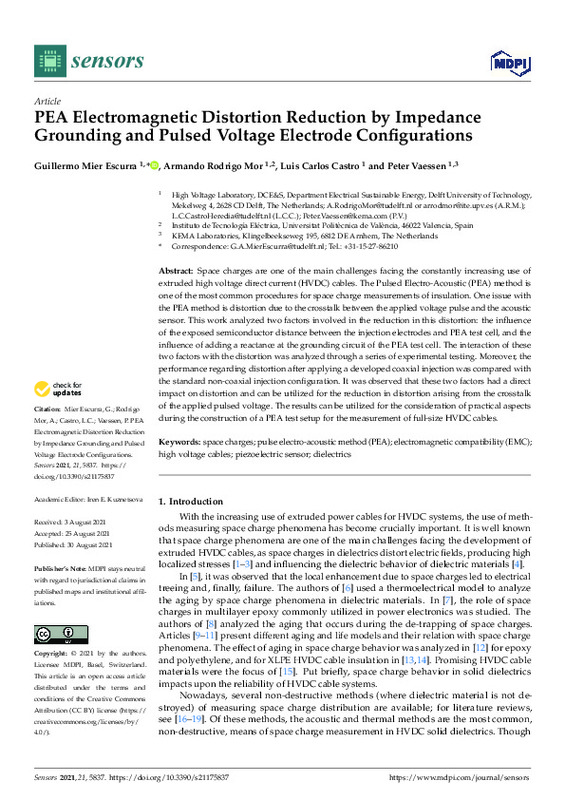JavaScript is disabled for your browser. Some features of this site may not work without it.
Buscar en RiuNet
Listar
Mi cuenta
Estadísticas
Ayuda RiuNet
Admin. UPV
PEA Electromagnetic Distortion Reduction by Impedance Grounding and Pulsed Voltage Electrode Configurations
Mostrar el registro sencillo del ítem
Ficheros en el ítem
| dc.contributor.author | Mier Escurra, Guillermo
|
es_ES |
| dc.contributor.author | Rodrigo Mor, Armando
|
es_ES |
| dc.contributor.author | Castro, Luis Carlos
|
es_ES |
| dc.contributor.author | Vaessen, Peter
|
es_ES |
| dc.date.accessioned | 2022-03-02T19:02:21Z | |
| dc.date.available | 2022-03-02T19:02:21Z | |
| dc.date.issued | 2021-09 | es_ES |
| dc.identifier.uri | http://hdl.handle.net/10251/181214 | |
| dc.description.abstract | [EN] Space charges are one of the main challenges facing the constantly increasing use of extruded high voltage direct current (HVDC) cables. The Pulsed Electro-Acoustic (PEA) method is one of the most common procedures for space charge measurements of insulation. One issue with the PEA method is distortion due to the crosstalk between the applied voltage pulse and the acoustic sensor. This work analyzed two factors involved in the reduction in this distortion: the influence of the exposed semiconductor distance between the injection electrodes and PEA test cell, and the influence of adding a reactance at the grounding circuit of the PEA test cell. The interaction of these two factors with the distortion was analyzed through a series of experimental testing. Moreover, the performance regarding distortion after applying a developed coaxial injection was compared with the standard non-coaxial injection configuration. It was observed that these two factors had a direct impact on distortion and can be utilized for the reduction in distortion arising from the crosstalk of the applied pulsed voltage. The results can be utilized for the consideration of practical aspects during the construction of a PEA test setup for the measurement of full-size HVDC cables. | es_ES |
| dc.description.sponsorship | This research was funded by Delt University of Technology. | es_ES |
| dc.language | Inglés | es_ES |
| dc.publisher | MDPI AG | es_ES |
| dc.relation.ispartof | Sensors | es_ES |
| dc.rights | Reconocimiento (by) | es_ES |
| dc.subject | Space charges | es_ES |
| dc.subject | Pulse electro-acoustic method (PEA) | es_ES |
| dc.subject | Electromagnetic compatibility (EMC) | es_ES |
| dc.subject | High voltage cables | es_ES |
| dc.subject | Piezoelectric sensor | es_ES |
| dc.subject | Dielectrics | es_ES |
| dc.subject.classification | INGENIERIA ELECTRICA | es_ES |
| dc.title | PEA Electromagnetic Distortion Reduction by Impedance Grounding and Pulsed Voltage Electrode Configurations | es_ES |
| dc.type | Artículo | es_ES |
| dc.identifier.doi | 10.3390/s21175837 | es_ES |
| dc.rights.accessRights | Abierto | es_ES |
| dc.contributor.affiliation | Universitat Politècnica de València. Departamento de Ingeniería Eléctrica - Departament d'Enginyeria Elèctrica | es_ES |
| dc.description.bibliographicCitation | Mier Escurra, G.; Rodrigo Mor, A.; Castro, LC.; Vaessen, P. (2021). PEA Electromagnetic Distortion Reduction by Impedance Grounding and Pulsed Voltage Electrode Configurations. Sensors. 21(17):1-12. https://doi.org/10.3390/s21175837 | es_ES |
| dc.description.accrualMethod | S | es_ES |
| dc.relation.publisherversion | https://doi.org/10.3390/s21175837 | es_ES |
| dc.description.upvformatpinicio | 1 | es_ES |
| dc.description.upvformatpfin | 12 | es_ES |
| dc.type.version | info:eu-repo/semantics/publishedVersion | es_ES |
| dc.description.volume | 21 | es_ES |
| dc.description.issue | 17 | es_ES |
| dc.identifier.eissn | 1424-8220 | es_ES |
| dc.identifier.pmid | 34502732 | es_ES |
| dc.identifier.pmcid | PMC8434225 | es_ES |
| dc.relation.pasarela | S\446278 | es_ES |
| dc.contributor.funder | Delft University of Technology | es_ES |








